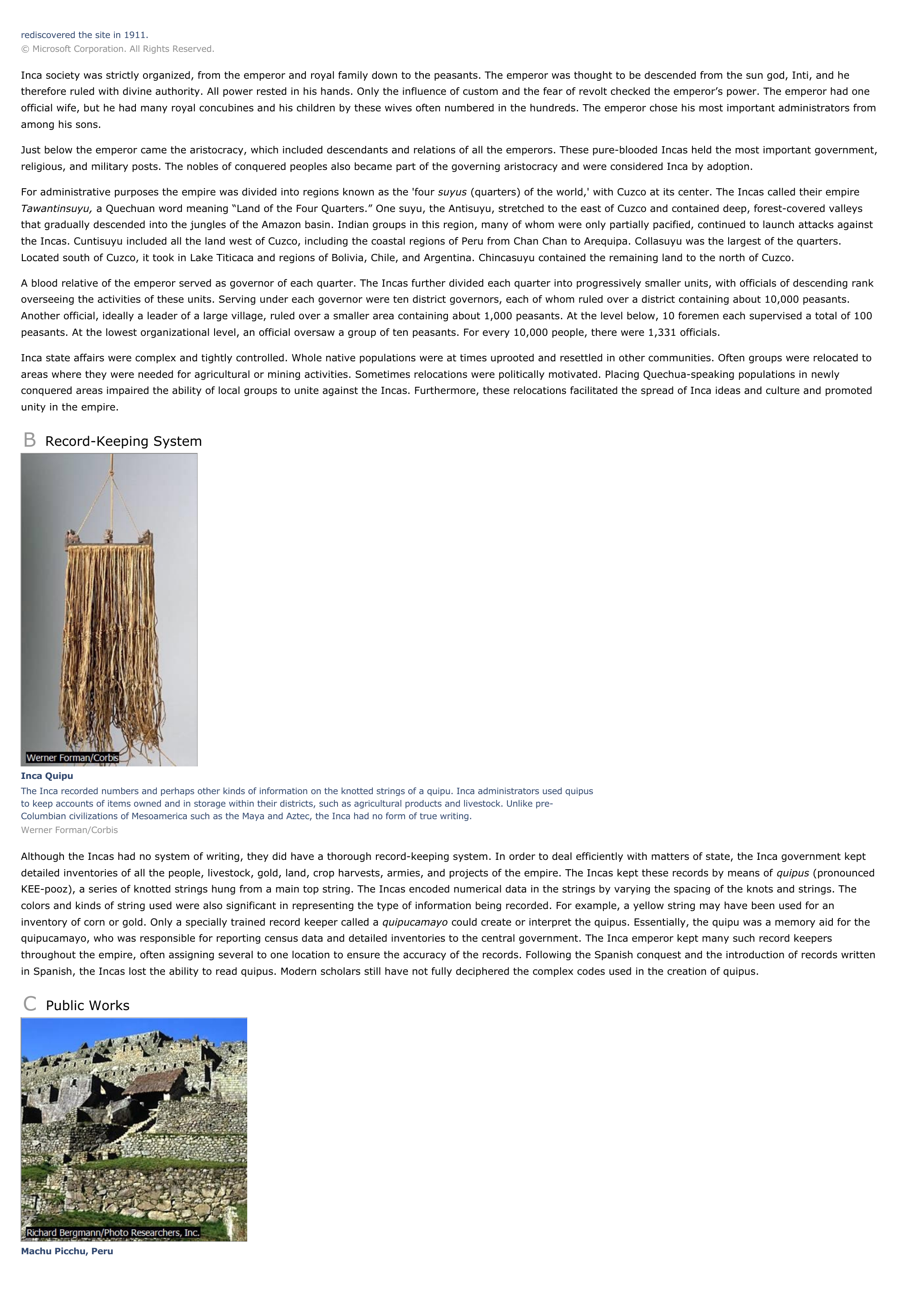Inca Empire - history.
Publié le 26/05/2013

Extrait du document
«
rediscovered the site in 1911.© Microsoft Corporation.
All Rights Reserved.
Inca society was strictly organized, from the emperor and royal family down to the peasants.
The emperor was thought to be descended from the sun god, Inti, and hetherefore ruled with divine authority.
All power rested in his hands.
Only the influence of custom and the fear of revolt checked the emperor’s power.
The emperor had oneofficial wife, but he had many royal concubines and his children by these wives often numbered in the hundreds.
The emperor chose his most important administrators fromamong his sons.
Just below the emperor came the aristocracy, which included descendants and relations of all the emperors.
These pure-blooded Incas held the most important government,religious, and military posts.
The nobles of conquered peoples also became part of the governing aristocracy and were considered Inca by adoption.
For administrative purposes the empire was divided into regions known as the 'four suyus (quarters) of the world,' with Cuzco at its center.
The Incas called their empire Tawantinsuyu, a Quechuan word meaning “Land of the Four Quarters.” One suyu, the Antisuyu, stretched to the east of Cuzco and contained deep, forest-covered valleys that gradually descended into the jungles of the Amazon basin.
Indian groups in this region, many of whom were only partially pacified, continued to launch attacks againstthe Incas.
Cuntisuyu included all the land west of Cuzco, including the coastal regions of Peru from Chan Chan to Arequipa.
Collasuyu was the largest of the quarters.Located south of Cuzco, it took in Lake Titicaca and regions of Bolivia, Chile, and Argentina.
Chincasuyu contained the remaining land to the north of Cuzco.
A blood relative of the emperor served as governor of each quarter.
The Incas further divided each quarter into progressively smaller units, with officials of descending rankoverseeing the activities of these units.
Serving under each governor were ten district governors, each of whom ruled over a district containing about 10,000 peasants.Another official, ideally a leader of a large village, ruled over a smaller area containing about 1,000 peasants.
At the level below, 10 foremen each supervised a total of 100peasants.
At the lowest organizational level, an official oversaw a group of ten peasants.
For every 10,000 people, there were 1,331 officials.
Inca state affairs were complex and tightly controlled.
Whole native populations were at times uprooted and resettled in other communities.
Often groups were relocated toareas where they were needed for agricultural or mining activities.
Sometimes relocations were politically motivated.
Placing Quechua-speaking populations in newlyconquered areas impaired the ability of local groups to unite against the Incas.
Furthermore, these relocations facilitated the spread of Inca ideas and culture and promotedunity in the empire.
B Record-Keeping System
Inca QuipuThe Inca recorded numbers and perhaps other kinds of information on the knotted strings of a quipu.
Inca administrators used quipusto keep accounts of items owned and in storage within their districts, such as agricultural products and livestock.
Unlike pre-Columbian civilizations of Mesoamerica such as the Maya and Aztec, the Inca had no form of true writing.Werner Forman/Corbis
Although the Incas had no system of writing, they did have a thorough record-keeping system.
In order to deal efficiently with matters of state, the Inca government keptdetailed inventories of all the people, livestock, gold, land, crop harvests, armies, and projects of the empire.
The Incas kept these records by means of quipus (pronounced KEE-pooz), a series of knotted strings hung from a main top string.
The Incas encoded numerical data in the strings by varying the spacing of the knots and strings.
Thecolors and kinds of string used were also significant in representing the type of information being recorded.
For example, a yellow string may have been used for aninventory of corn or gold.
Only a specially trained record keeper called a quipucamayo could create or interpret the quipus.
Essentially, the quipu was a memory aid for the quipucamayo, who was responsible for reporting census data and detailed inventories to the central government. The Inca emperor kept many such record keepers throughout the empire, often assigning several to one location to ensure the accuracy of the records.
Following the Spanish conquest and the introduction of records writtenin Spanish, the Incas lost the ability to read quipus.
Modern scholars still have not fully deciphered the complex codes used in the creation of quipus.
C Public Works
Machu Picchu, Peru.
»
↓↓↓ APERÇU DU DOCUMENT ↓↓↓
Liens utiles
- Inca Empire - History.
- Ottoman Empire - history.
- Roman Empire - history.
- Aztec Empire - history.
- Inca Empire.
























